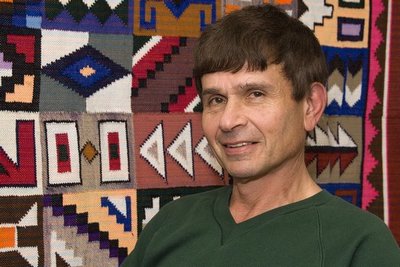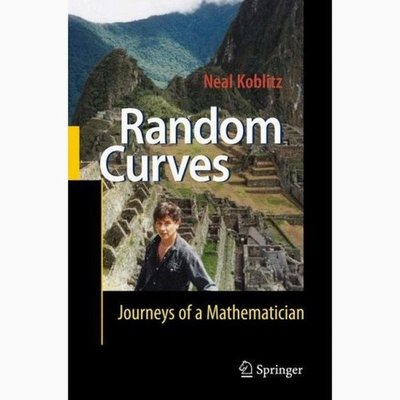November 8, 2007
Neal Koblitz: Deciphering the cryptographer
Someone who didn’t know Neal Koblitz might be surprised to hear that in the past few months, the mathematics professor has been embroiled in a public controversy, traveling the world for humanitarian causes, and publishing his autobiography. Those who know him will be less taken aback.
For the past 28 years, Koblitz has been one of the more multifaceted members of the UW’s Department of Mathematics. This month he publishes Random Curves: Journeys of a Mathematician. The autobiography tells the story of attending college during the 1960s, living in the Soviet Union for a year and a half in the 1970s, traveling the world with his wife to promote women’s involvement in science and mathematics — not to mention more than two decades at the center of cryptographic research.
The idea for a book came about last year, when Koblitz was telling stories at a conference and friends suggested he write down his experiences. He decided an autobiography was worth pursuing, partly to give a view of his profession that the public seldom sees.
“I want to convey an image of the life of a mathematician that’s a bit different from the image that a lot of people have, of being totally wrapped up in arcane calculations,” Koblitz said. Recent portrayals have unfortunately focused on mathematicians who were also mentally ill — the main characters in the movies A Beautiful Mind and Proof, for example. (The television program Numb3rs, Koblitz admits, presents a saner picture.)
But it wasn’t only his mathematical life that seemed worth recording. “I also write from the standpoint of someone from my generation, who went to college in the 1960s and was very much wrapped up in the events of that generation,” said the 1969 Harvard graduate. “Except for a small number of celebrities, there aren’t that many people who have written about those times.”
While Koblitz’s account of the 1960s may be more representative of the generation than, for instance, the exploits in Eric Clapton’s new autobiography, they are hardly commonplace. Koblitz studied Russian in high school; while pursuing his undergraduate degree at Harvard University in the mid 1960s he translated Russian articles for the American Mathematical Society. It earned him enough money to travel to the Soviet Union while still a student.
“I was fully wrapped up in the mathematical life of Moscow,” Koblitz recalls. “I think in mathematics, more than almost any area, you can really put political questions aside.”
In the mid 1980s Koblitz entered the field of cryptography, the study of devising and breaking codes. He was immediately captivated by both the discipline and the academic culture.
“When I was starting, [cryptography] was in a very free-wheeling, exciting period,” Koblitz recalls, “partly because there was an element of forbidden fruit.” The National Security Agency tried in 1981 to stop academics from publishing on cryptography without first submitting their work to the NSA. “Ultimately, nothing came of it, except that people [in academia] got very angry at NSA.”
In those days, cryptography had more a military than an economic importance.
“In the mid 1980s, most people weren’t worried about security issues in the electronic sense,” Koblitz says. “Data security meant you got a lock for your file cabinet.'”
In retrospect, it’s hard to believe that in the mid 1980s when Koblitz discovered elliptic key cryptography — a strategy for encrypting data that’s since been turned into a company — he didn’t even patent his discovery. It wasn’t until the 1990s brought the Internet and hacking that electronic security became big business. These changes are described in a chapter of the new book, and in an article Koblitz published in September in Notices of the American Mathematical Society titled “The Uneasy Relationship Between Mathematics and Cryptography.”
The article tells of the political swings and turf wars in cryptography. And it’s the article that has landed him in the midst of controversy.
After the NSA’s unsuccessful attempt to ban academic publishing, the agency began to fund cryptographic research, but Koblitz argues the money was a double-edged sword. Mathematicians began to cater to the government funding agencies. He recounts reviewing a grant application that stated the proposed research would give the U.S. a competitive advantage in a certain area of mathematics, which Koblitz viewed as contrary to mathematics’ spirit of international collaboration.
But it turns out, surprisingly, that the article’s most controversial points were Koblitz’s comments on the interactions between mathematicians and computer scientists. The interdisciplinary nature of cryptography — which straddles mathematics, computer science and engineering — was one of the things that first attracted Koblitz to the field. But the cross-cultural tensions can be taxing. In the article, Koblitz characterizes members of his own discipline as prone to bandwagon-jumping and eager to please the funding agencies. He suggests computer scientists are inclined to publish too often, and have a definition of the word “proof” that differs from what’s accepted in mathematics circles.
Though meant to be entertaining more than accusative, the article has created a buzz in the blogosphere. And the next issue of the AMS Notices will include four irate letters written in response to Koblitz’s piece, as well as a counter-response by Koblitz.
“I was a bit taken aback by how angry some of [the responses] were,” Koblitz admits. “In mathematics, for the most part, there’s a long tradition of being able to take criticism.” The thick skin might come from seeing a much younger researcher prove a theorem you’d been trying for decades to prove, he says. It might also develop in the classroom. “Mathematicians teach calculus, and we get our student evaluations at the end of the quarter. You can’t survive too long if you’re thin-skinned,” Koblitz jokes.
Koblitz is an internationally known mathematician who earned his doctorate at Princeton University, holds an adjunct appointment at the University of Waterloo in Canada and has chaired the program committee for the world’s top cryptographic conference. Yet his blackboard shows a list of appointments that serve as a low-tech calendar. And while he does have a computer, it is relegated to a side table.
“Interdisciplinary research, in some ways, is like a marriage,” Koblitz says. “People from different backgrounds have to learn to work together.”
Koblitz and his wife have learned to overcome their own challenges, in this case geographic challenges. Like many academic couples, Koblitz and his wife have a long-distance relationship. Ann Hibner Koblitz is a professor of women’s studies at Arizona State University in Tempe.
“We go back and forth,” Koblitz says. “She is on a semester system, so very often when she’s teaching the UW is between quarters.”
They also often travel together to Vietnam, Mexico, Cuba and South America as directors of their charity, The Kovalevskaia Fund. In 1983 Ann published a biography of Russian mathematician, socialist and feminist Sofia Kovalevskaia. The couple decided to use the royalties of the book to award scholarships and prizes to young women from developing countries who were pursuing mathematics and science. It wasn’t a lot of money, but donations have increased the pot and the number of programs.
“Neal is a very dedicated person — to his politics, and to his research, and to his teaching,” said Tom Duchamp, professor in the Department of Mathematics who has been a friend and colleague since the early 1980s. “He’s a bit unusual in that way.”
Koblitz’s book is being published by Springer-Verlag; it will be available in stores and online next month.


